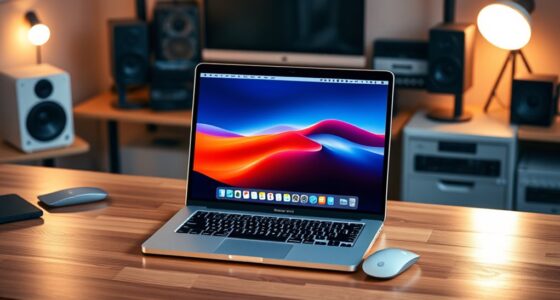We’ve found the top 15 astronomy laptops with excellent battery life that are perfect for stargazing and space exploration. These models feature large, vivid full HD displays, powerful processors like 12th Gen Intel Core chips, and ample storage up to 1TB SSD. They’re lightweight, portable, and include features such as long-lasting batteries and fast energy-efficient components. Keep exploring, and you’ll discover the best options to enhance your celestial adventures.
Key Takeaways
- Look for laptops with 8+ hours of battery life and high-capacity batteries (50Wh+), suitable for extended outdoor stargazing sessions.
- Prioritize models with energy-efficient 12th Gen Intel processors and low TDP components for better power management.
- Choose lightweight, portable designs (under 4 pounds) with durable materials for easy field transport.
- Opt for high-resolution Full HD IPS displays with anti-glare coatings to enhance celestial viewing without straining your eyes.
- Ensure connectivity options like USB-C, HDMI, Wi-Fi 6, and Bluetooth 5.2 for seamless data transfer and device compatibility in the field.
17.3-inch Laptop with 16GB RAM and 512GB SSD

If you’re looking for a portable yet powerful laptop for stargazing adventures, the 3-inch model with 16GB RAM and 512GB SSD is an excellent choice. This sleek device combines a 17.3-inch IPS FHD display with a lightweight design, weighing just under 6 pounds. Powered by the latest 12th gen Intel N97 processor and ample RAM, it handles multitasking and demanding apps effortlessly. The fast NVMe SSD ensures quick boot times and data access, ideal for astronomy software. Plus, with multiple ports and long battery life, you can enjoy extended stargazing sessions without worrying about performance or connectivity.
Best For: users seeking a portable, high-performance laptop for multitasking, entertainment, and on-the-go productivity.
Pros:
- Large 17.3-inch IPS FHD display offers immersive viewing experience
- Powerful 12th gen Intel N97 processor with 16GB RAM handles demanding tasks smoothly
- Lightweight design (under 6 pounds) and compact dimensions for easy portability
Cons:
- Battery life of approximately 5 hours may require frequent recharging during extended use
- Slightly higher price point compared to budget models with less advanced specs
- Limited to Windows 11 Pro, which may not suit users preferring other operating systems
ACEMAGIC 2025 17.3-Inch FHD Laptop with 12th Gen Quad-Core Processor
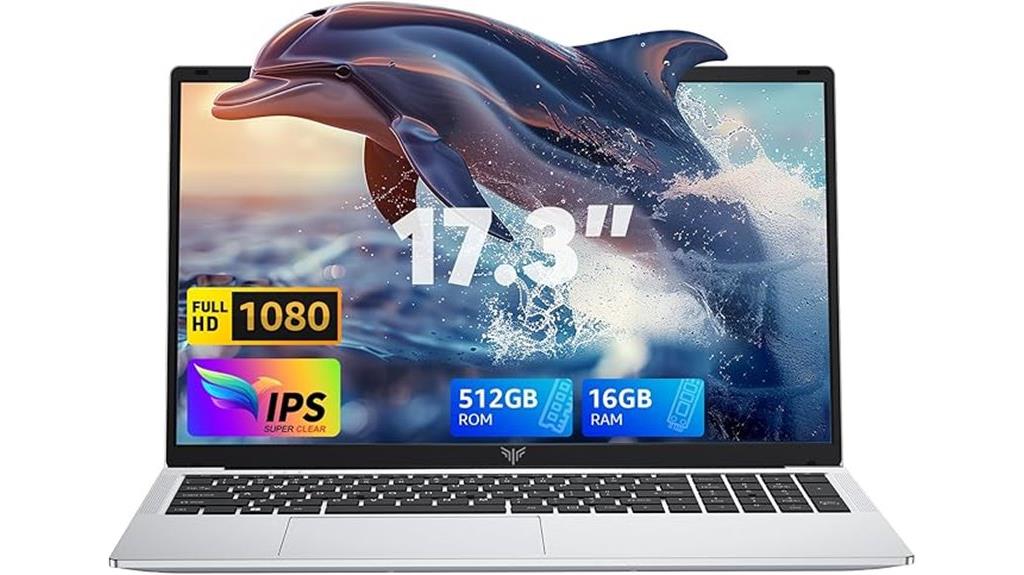
The ACEMAGIC 2025 17.3-Inch FHD Laptop is an excellent choice for stargazing enthusiasts who want a portable yet powerful device. Its 12th Gen Intel Alder Lake N97 processor, combined with 16GB DDR4 RAM and a 512GB SSD, ensures smooth multitasking and quick data access. The large 17.3-inch FHD IPS display offers an immersive viewing experience, perfect for observing star maps or streaming space documentaries. With a 6000mAh battery, you get up to 5 hours of use, making it suitable for outdoor sessions. The durable metal chassis, multiple connectivity options, and quiet cooling fans make this laptop both reliable and user-friendly for space explorers on the go.
Best For: astronomy enthusiasts and space explorers seeking a portable, high-performance laptop for stargazing, streaming space documentaries, and outdoor use.
Pros:
- Powerful 12th Gen Intel Alder Lake N97 processor with 16GB DDR4 RAM for smooth multitasking
- Large 17.3-inch FHD IPS display for immersive viewing experiences
- Durable metal chassis combined with portability and long battery life up to 5 hours
Cons:
- Battery life may be limited for extended outdoor use without access to power
- Heavier than ultra-lightweight laptops due to its sizable display and metal build
- Limited to data transfer via Type-C (no Thunderbolt support) and no dedicated GPU
Laptop Computer with 15.6″ FHD IPS Display, Celeron N5095 Processor, 12GB RAM, 512GB SSD, Expandable to 1TB, WiFi 2.4G+5G, 2-Year Warranty
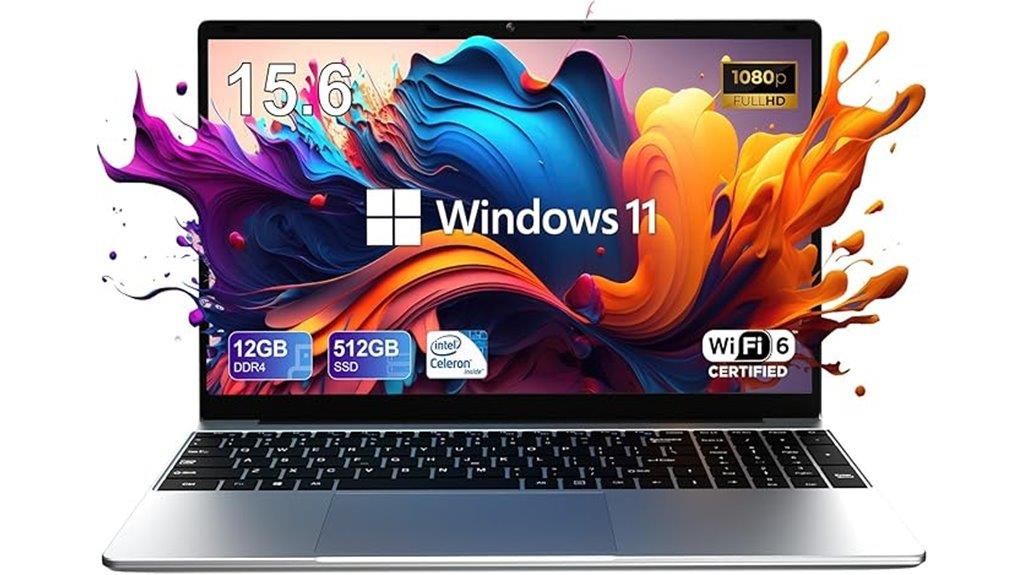
Designed for those who need a portable, high-performance device for both work and leisure, this 15.6-inch FHD IPS laptop offers vivid visuals and fast processing with its Celeron N5095 processor and 12GB of RAM. It handles multitasking, media editing, and large files smoothly. The 512GB SSD provides quick storage, expandable to 1TB for extra space. Its sleek, ultralight design (~3 pounds) makes it easy to carry around. With WiFi 2.4G+5G, a full set of ports, and a 2-year warranty, it’s reliable for travel, study, or outdoor stargazing sessions. This laptop balances power, portability, and value perfectly.
Best For: students, remote workers, and professionals seeking a lightweight, high-performance laptop for multitasking, media editing, and portability.
Pros:
- Powerful performance with Jasper Lake N5095 processor and 12GB RAM for smooth multitasking
- Vibrant 15.6-inch FHD IPS display with thin bezels for immersive viewing
- Lightweight (~3 pounds) with ultrathin design and fast-charging portable charger for easy portability
Cons:
- Limited to 512GB SSD storage, which may require expansion for extensive data needs
- Celeron N5095 processor, while capable, may not handle very intensive tasks as efficiently as higher-end CPUs
- No dedicated graphics card, limiting performance in high-end gaming or advanced 3D rendering
HP Flagship Laptop with Windows 11 Pro and AI Features
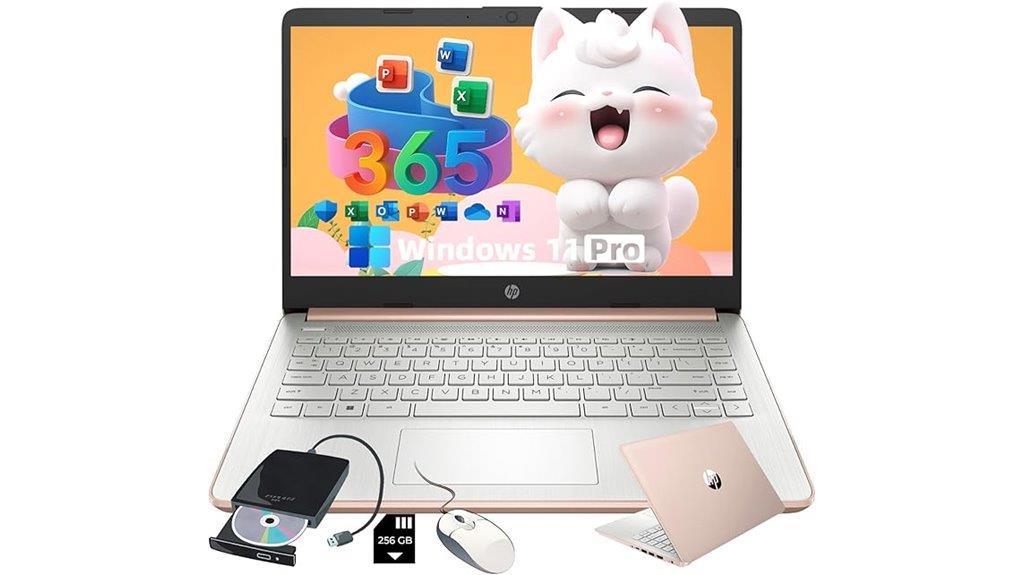
For stargazing enthusiasts who also need a reliable, portable device, the HP Flagship Laptop with Windows 11 Pro and AI features stands out as an ideal choice. Its lightweight design (just over 3 pounds) and sturdy build make it perfect for on-the-go use. With a long-lasting battery of up to 11.5 hours and fast charging, you can enjoy extended skywatching sessions. The powerful Intel quad-core processor, up to 32GB of RAM, and integrated AI-powered Microsoft 365 enhance productivity. Plus, its versatile 14-inch display, multiple ports, and included accessories make it a practical companion for both space exploration and everyday tasks.
Best For: outdoor enthusiasts, students, and remote workers seeking a lightweight, durable, and high-performance laptop for on-the-go productivity and entertainment.
Pros:
- Long-lasting battery life up to 11.5 hours with fast charging capability
- Lightweight and sturdy design, weighing just over 3 pounds for portability
- Powerful Intel quad-core processor with up to 32GB RAM and AI-enhanced Microsoft 365
Cons:
- Battery life may not fully last an entire day for intensive use
- Occasional issues reported with built-in mouse and sleep mode activation
- Limited internal storage (128GB UFS) may require external expansion for large files
NIMO 15.6″ FHD Laptop with 16GB RAM and 1TB SSD

If you’re looking for a reliable laptop to accompany your stargazing sessions, the NIMO 15.6″ FHD Laptop stands out with its vibrant display and robust performance. Its 15.6-inch anti-glare screen with 1920×1080 resolution minimizes eye strain during long night observations. Powered by an Intel Alder Lake-N100 processor and 16GB DDR4 RAM, it handles multitasking and data transfers swiftly, thanks to the 1TB PCIe SSD. The sturdy metal shell ensures durability, while features like Wi-Fi 6 and Bluetooth 5.2 keep you connected. Weighing just 3.8 pounds, it’s portable enough for outdoor use, making it a solid choice for space explorers on the go.
Best For: students, professionals, and casual users seeking a reliable, portable laptop with excellent performance for multitasking and multimedia tasks.
Pros:
- Vibrant 15.6-inch FHD anti-glare display reduces eye strain during extended use
- Fast performance with Intel Alder Lake-N100 processor, 16GB RAM, and 1TB SSD for quick multitasking and data transfers
- Durable metal shell, lightweight design (3.8 pounds), and additional features like Wi-Fi 6 and Bluetooth 5.2 for connectivity
Cons:
- Battery life averages around 3-5 hours, which may require frequent charging during extended use
- Slight learning curve with Windows 11 features such as pinch-to-zoom and gesture controls
- Speakers may lack deep bass despite clear audio at high volume
NIMO 15.6″ IPS FHD Laptop with 16GB RAM and 1TB SSD
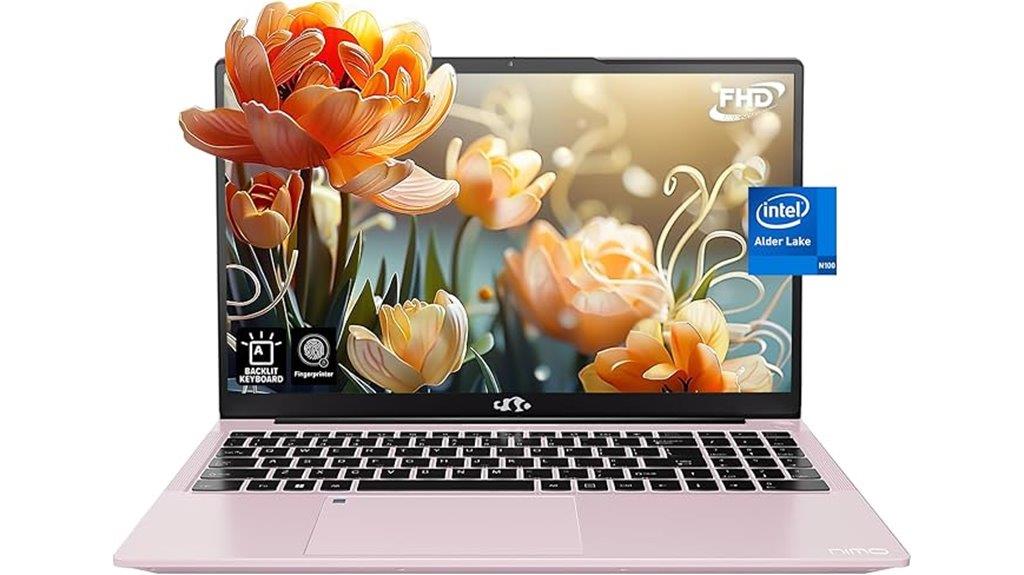
The NIMO 15.6″ IPS FHD Laptop stands out as an excellent choice for stargazing enthusiasts who want a portable, high-performance device for celestial observation and astrophotography. Its sleek rose gold design, lightweight build, and durable metal shell make it easy to carry outdoors. The bright, anti-glare 15.6-inch display provides sharp visuals, perfect for viewing star charts or editing astrophotos. Powered by a fast 12th Gen Intel processor, 16GB RAM, and a 1TB SSD, it handles multitasking and data storage effortlessly. Features like Wi-Fi 6 and a fingerprint sensor add convenience, making it a reliable companion for space exploration adventures.
Best For: astronomy enthusiasts and astrophotographers seeking a portable, high-performance laptop for celestial observation and image editing.
Pros:
- Sleek rose gold design with lightweight, durable metal shell for easy outdoor portability
- Bright, anti-glare 15.6-inch display ideal for star charts and astrophotography editing
- Powerful 12th Gen Intel processor, 16GB RAM, and 1TB SSD ensure smooth multitasking and fast data access
Cons:
- Battery life of approximately 5 hours may be limited for extended stargazing sessions without access to power
- Touchpad and keyboard layout adjustments reported by some users could affect initial comfort
- Slightly higher price point around $449 may be a consideration for budget-conscious buyers
Laptop Computer with 15.6″ HD Display, 12GB RAM, 512GB SSD

A 15.6-inch Full HD IPS display with a thin-bezel design makes this laptop an excellent choice for stargazing enthusiasts who want a clear, immersive view of star maps and celestial images. Its vivid visuals support detailed observation without eye strain. Equipped with 12GB of RAM and a 512GB SSD, it handles multitasking smoothly and offers quick data access. Powered by a Jasper Lake N5095 processor, it’s suitable for light tasks, photo editing, and casual gaming. Its lightweight design makes it portable, and the battery life of around 6 hours is generally enough for outdoor use. Overall, it’s a versatile, budget-friendly option for amateur astronomers.
Best For: amateur astronomers and casual users seeking a portable, budget-friendly laptop for star map viewing, photo editing, and light gaming.
Pros:
- Vivid 15.6-inch Full HD IPS display offers immersive and clear visuals.
- Lightweight and compact design enhances portability for outdoor use.
- Fast boot times and smooth multitasking with 12GB RAM and SSD storage.
Cons:
- Battery life of around 6 hours may be limited for extended outdoor sessions.
- Lacks touchscreen functionality and biometric security features.
- Occasional bugs like sleep mode issues and software slowdowns can affect user experience.
2025 Laptop with N97 CPU, 8GB DDR4 RAM, 256GB SSD, 15.6″ FHD Display, 5000mAh Battery, Metal Body, Portable Slim Laptop

For stargazing enthusiasts who need a portable yet capable device, this 15.6-inch slim laptop with an N97 CPU and 8GB RAM offers a perfect balance of performance and mobility. Its Intel N97 processor delivers a solid speed of up to 3.6GHz, supporting smooth multitasking and light gaming. The 256GB SSD ensures quick load times and efficient data access, while the vibrant FHD display provides sharp visuals ideal for analyzing star charts or watching space documentaries. Weighing just 1.6kg with a durable metal body, it’s easy to carry on trips. The 5000mAh battery offers over four hours of use, making it a reliable companion for your astronomy adventures.
Best For: portable professionals, students, and enthusiasts seeking a lightweight, reliable device for multitasking, media consumption, and light gaming.
Pros:
- Slim, lightweight design weighing only 1.6kg for easy portability
- Fast 256GB SSD ensures quick load times and efficient data access
- Vibrant 15.6″ FHD IPS display provides sharp visuals with accurate colors
Cons:
- Battery life of just over 4 hours may be limited for extended use away from power sources
- Intel N97 CPU, while capable, may not handle demanding applications or heavy multitasking with ease
- Limited to 8GB RAM, which might restrict performance during intensive multitasking or future software updates
ACEMAGIC 17.3 Laptop with Quad Core-12th Alder Lake N97 Processor

Are you searching for a portable laptop that can handle stargazing apps and multimedia with ease? The ACEMAGIC 17.3-inch laptop is a solid choice, featuring a 12th gen Alder Lake N97 quad-core processor up to 3.6GHz, 16GB DDR4 RAM, and a 512GB SSD. Its lightweight metal chassis weighs just 3.52 pounds, making it easy to carry. The Full HD IPS display offers immersive visuals, perfect for astronomy viewing. With extensive connectivity options like USB-C, HDMI, and WiFi 6, it supports multitasking and media sharing. While the battery lasts about five hours, it’s a versatile, budget-friendly option for stargazing and space exploration enthusiasts.
Best For: budget-conscious users seeking a portable, high-performance laptop suitable for multimedia, light gaming, and stargazing applications.
Pros:
- Lightweight metal chassis weighing only 3.52 pounds for portability
- Large 17.3-inch Full HD IPS display with immersive visuals
- Powerful 12th gen Alder Lake N97 quad-core processor and 16GB RAM for multitasking
Cons:
- Battery life of approximately five hours may be limiting for extended use away from power sources
- Lacks touchscreen and backlit keyboard features
- Performance may experience slowdowns under heavy workloads or demanding applications
ACEMAGIC 2024 17.3-Inch FHD Laptop with 12th Gen Quad-Core Processor, 16GB RAM, 512GB SSD, Battery and Business Features

If you’re looking for a portable and reliable laptop to enhance your stargazing experience, the ACEMAGIC 2024 17.3-Inch FHD Laptop stands out with its powerful 12th Gen Quad-Core Processor and ample 16GB RAM, ensuring smooth multitasking and quick data processing. Its 17.3-inch bezel-free display offers immersive viewing, ideal for space exploration. The long-lasting 6000mAh battery provides up to 5 hours of use, reducing the need for frequent charging during outdoor sessions. With multiple connectivity options, including HDMI, USB-C, and Bluetooth 5.0, it’s perfect for connecting accessories or external displays, all in a slim, lightweight design with excellent support.
Best For: outdoor enthusiasts and astronomy fans seeking a portable, high-performance laptop for stargazing and space exploration.
Pros:
- Powerful 12th Gen Quad-Core Processor and 16GB RAM ensure smooth multitasking and quick data processing.
- 17.3-inch bezel-free FHD display provides immersive viewing ideal for space observations.
- Long-lasting 6000mAh battery offers up to 5 hours of use, perfect for outdoor sessions.
Cons:
- Limited battery life for extended outdoor use beyond 5 hours.
- Heavier than smaller ultrabooks, which may affect portability for some users.
- May require additional accessories for specialized stargazing equipment connectivity.
15.6 Inch Laptop Computer with 16GB RAM and 512GB SSD
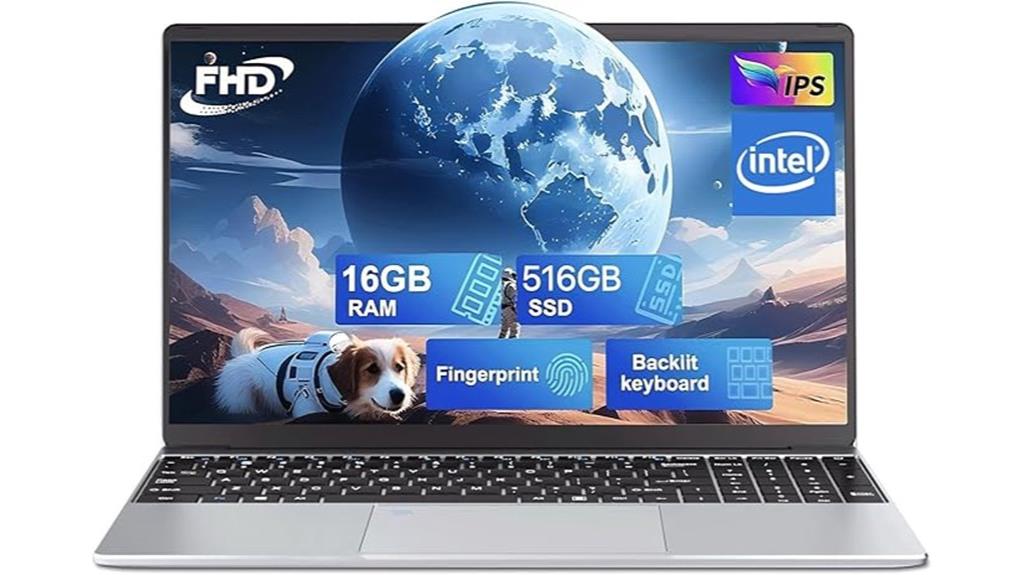
A 6-inch laptop with 16GB of RAM and a 512GB SSD offers unmatched portability for stargazing enthusiasts who want to explore celestial maps or run astronomy apps on the go. Its compact size makes it ideal for travelers and night sky explorers who need a lightweight device that fits easily into pockets or small bags. Despite its small form factor, it delivers powerful performance with ample RAM and fast SSD storage, ensuring smooth multitasking and quick access to data. Perfect for quick star chart checks or running astronomy software in remote locations, it combines convenience with capable specs.
Best For: students, professionals, and casual users seeking a lightweight, versatile laptop with strong performance for multitasking, presentations, streaming, and light gaming.
Pros:
- Compact, lightweight design weighing only 3.54 pounds for easy portability
- Powerful 16GB RAM and 512GB SSD ensure smooth multitasking and fast data access
- Features secure fingerprint login, backlit keyboard, and high-quality Full HD IPS display for comfortable use in various environments
Cons:
- Limited battery life of approximately 5 hours may require frequent charging during extended use
- Optical BD-R drive may be unnecessary for most users and adds bulk
- Slightly higher price point due to premium specs and build quality
New Laptop with 15.6″ FHD IPS Display, 8GB RAM, 256GB SSD, N5095 CPU, WiFi, Bluetooth, USB-C PD3.0 Fast Charging
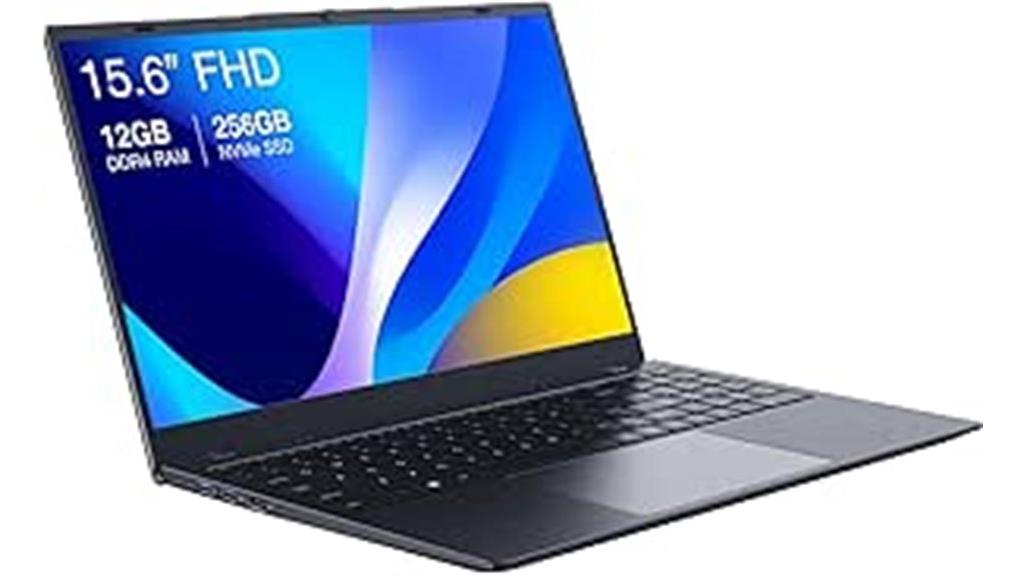
This lightweight 15.6-inch laptop with a vivid FHD IPS display is perfect for stargazing enthusiasts who want a portable device to explore celestial images or run astronomy apps from anywhere. Weighing just 3.41 pounds, it’s easy to carry on outdoor adventures or between locations. Powered by an 11th Gen Intel N5095 quad-core processor, it handles multitasking smoothly, while 8GB RAM ensures responsiveness. The 256GB NVMe SSD provides fast storage, and the full HD display offers detailed, rich visuals. Plus, support for USB-C PD3.0 fast charging keeps it ready quickly, making it an ideal companion for space exploration on the go.
Best For: outdoor enthusiasts, students, and professionals seeking a lightweight, portable laptop for astronomy, multimedia, and everyday tasks.
Pros:
- Compact and lightweight design weighing only 3.41 pounds for easy portability
- Vibrant 15.6-inch FHD IPS display with detailed visuals perfect for stargazing and multimedia use
- Fast performance with 11th Gen Intel N5095 quad-core CPU, 8GB RAM, and 256GB NVMe SSD
Cons:
- Limited to 256GB storage, which may require external drives for extensive data
- No dedicated graphics card, potentially affecting high-end gaming or graphics-intensive applications
- Basic Bluetooth version (4.2) and connectivity options might lack some advanced features needed for certain peripherals
Laptop Computer 15.6in with Backlit Keyboard, 1TB SSD & 16GB RAM
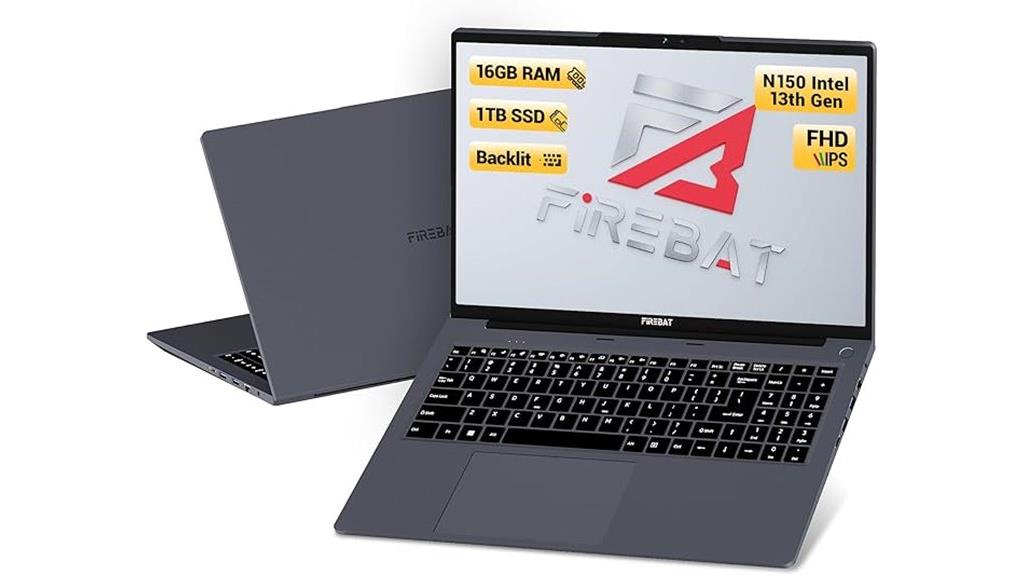
The 15.6-inch Laptop with Backlit Keyboard, 1TB SSD, and 16GB RAM stands out as an excellent choice for stargazing enthusiasts who need a portable device with powerful performance and ample storage. It features the latest Intel 13th Gen N150 processor, delivering a 30% speed boost over previous versions, perfect for multitasking and quick data processing. The crisp FHD IPS display offers sharp visuals, while the backlit keyboard enhances usability in low-light conditions. With a large 1TB SSD and 16GB RAM, I can store plenty of star maps, astronomy software, and media files, all powered by a long-lasting battery for extended outdoor use.
Best For: outdoor enthusiasts, students, and professionals who need a portable, high-performance laptop with ample storage for multitasking and multimedia use.
Pros:
- Powerful Intel 13th Gen N150 processor with a 30% performance boost for efficient multitasking
- Large 1TB SSD and 16GB RAM ensure fast data access and ample storage space
- Long-lasting 5000mAh battery provides extended usage for outdoor and on-the-go activities
Cons:
- Limited to Wi-Fi 5, which is slower than the latest Wi-Fi 6/6E standards
- May lack some high-end features found in premium laptops, such as Thunderbolt ports or 4K display
- Slightly heavier than ultra-lightweight models, which could affect portability during long outdoor excursions
ACEMAGIC 2025 AX16 16-inch Laptop with 16GB RAM and 512GB SSD
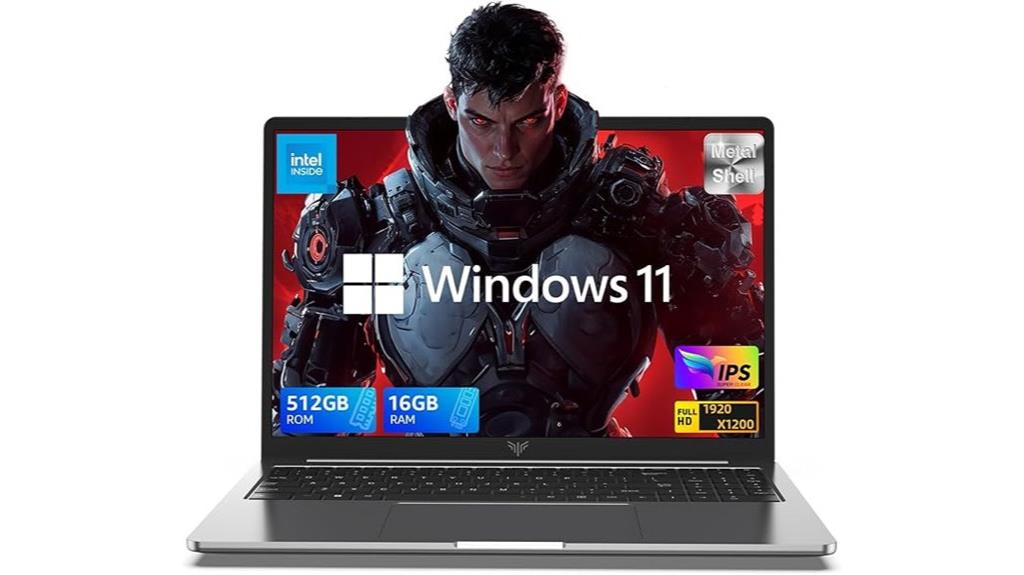
With its vivid 16-inch display featuring wide viewing angles, the ACEMAGIC 2025 AX16 is an excellent choice for stargazing enthusiasts who want a portable device to explore night sky images or astronomy apps. Its sleek metal shell and slim bezels provide a modern look, while the 1920×1200 FHD resolution guarantees sharp visuals. Weighing about 5.6 pounds, it strikes a good balance between portability and screen size. Powered by a 12th Gen Intel Alder Lake quad-core processor, 16GB RAM, and a 512GB SSD, it delivers solid multitasking and quick load times, making it suitable for both casual stargazing and light multimedia tasks.
Best For: casual users and light multitaskers seeking a portable, stylish laptop with a vivid display for multimedia, light gaming, or astronomy app enthusiasts.
Pros:
- Vivid 16-inch display with wide viewing angles and sharp 1920×1200 resolution
- Sleek metal shell with slim bezels for a modern, attractive design
- Powerful 12th Gen Intel Alder Lake quad-core processor with 16GB RAM for smooth multitasking
Cons:
- Mixed customer reviews regarding connectivity and graphics performance issues
- Battery life of approximately 8 hours may be limiting for extended use without charging
- Slightly heavier at around 5.6 pounds, which may impact portability for some users
ACEMAGIC 2024 17.3-Inch FHD Laptop with 16GB RAM and 512GB SSD

If you’re looking for a laptop that combines a large, crisp display with solid performance, the ACEMAGIC 2024 17.3-inch FHD model is an excellent choice for stargazing enthusiasts. Its vibrant 1920×1080 screen offers clear visuals, perfect for viewing star maps or space documentaries. Powered by a 12th Gen Intel Alder Lake N97 processor and 16GB RAM, it handles multitasking smoothly. The 512GB SSD provides quick access to files, while the 6000mAh battery offers all-day use. Weighing just 4.4 pounds, it’s portable enough for outdoor astronomy sessions, making it a versatile, budget-friendly option for space lovers.
Best For: space enthusiasts and outdoor astronomers seeking a portable, high-performance laptop for stargazing, space documentaries, and multitasking on the go.
Pros:
- Large 17.3-inch FHD display with vibrant, clear visuals ideal for viewing star maps and videos
- Powerful 12th Gen Intel Alder Lake N97 processor with 16GB RAM ensures smooth multitasking
- Lightweight design at 4.4 pounds with all-day battery life makes it highly portable for outdoor use
Cons:
- Battery life may vary, with some users reporting around 5 to 5.5 hours, which might be limited for extended outdoor sessions
- Potential quality control issues, such as setup difficulties or device shutting off after initial use, have been reported
- Limited to basic wireless connectivity (802.11ac Wi-Fi), which may not support the fastest internet speeds in some locations
Factors to Consider When Choosing Astronomy Laptops With High Battery Life
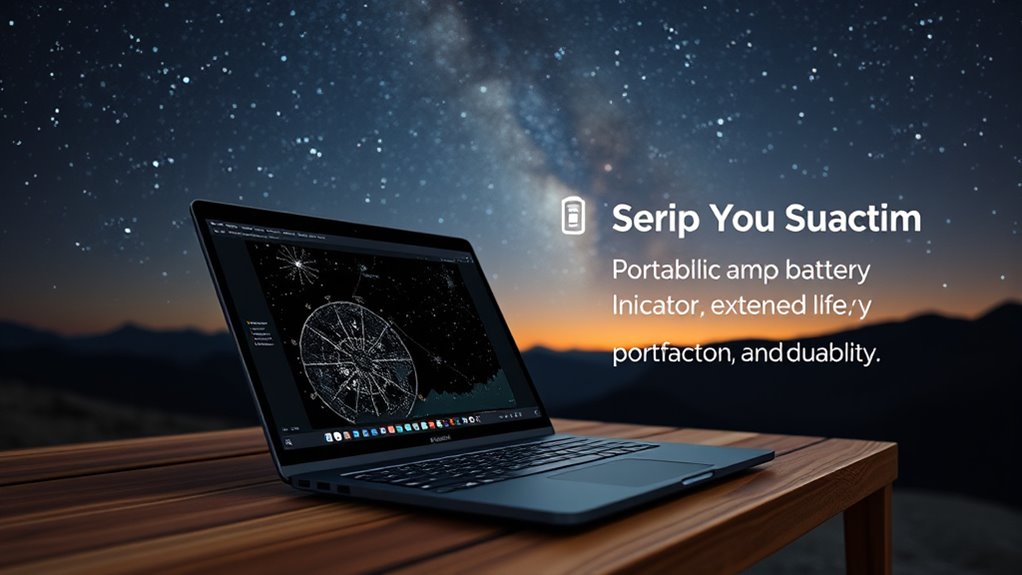
When selecting an astronomy laptop with high battery life, we need to consider factors like battery capacity, power efficiency, and processor energy use. Settings like display brightness and hardware features also play a vital role in extending runtime. By understanding these points, we can choose a device that keeps us stargazing longer without interruption.
Battery Capacity and Duration
A laptop’s battery capacity, measured in milliampere-hours (mAh) or watt-hours (Wh), plays an essential role in guaranteeing extended stargazing sessions. Generally, higher capacities—at least 5000mAh or 50Wh—offer longer usage times, reducing the need for frequent recharges during outdoor observations. However, battery life isn’t solely determined by capacity; the system’s power efficiency matters too. Even a large-capacity battery can drain quickly if the laptop isn’t optimized for low power consumption. Features like power-saving modes and hardware optimization can markedly extend battery life. Keep in mind that real-world endurance varies with workload—light tasks like browsing consume less power, while intensive activities such as data analysis drain batteries faster. Choosing the right balance ensures uninterrupted stargazing adventures.
Power Efficiency Technologies
To maximize battery life during long stargazing sessions, it’s important to focus on power efficiency technologies integrated into modern laptops. Advanced CPU power management and low-voltage components help extend battery life by reducing energy consumption during idle or low-demand tasks. Features like integrated graphics and energy-efficient display panels further cut power use during extended use. Modern laptops also employ intelligent thermal management systems and dynamic voltage adjustments, optimizing energy use without sacrificing performance. Power-saving modes and software optimizations play a vital role in maintaining high battery life during intensive tasks like astronomical data analysis. Additionally, advancements in battery technology, such as high-capacity cells and fast-charging capabilities, support longer usage periods with minimal downtime, ensuring you’re ready for those long nights under the stars.
Processor Energy Use
Choosing the right processor is critical for maximizing battery life in astronomy laptops, especially during long stargazing sessions. Processors with lower thermal design power (TDP), like those rated at 15W or less, use less energy, helping extend your battery life. Modern architectures such as Intel’s Alder Lake and AMD’s Ryzen series include advanced power management features that reduce energy consumption during idle or low-demand tasks. Newer processor generations often incorporate energy-saving technologies, further improving battery longevity. Be mindful that multithreaded processors with many cores can increase power consumption if all cores run simultaneously, so balancing performance and efficiency is key. Additionally, integrated graphics typically consume less power than discrete GPUs, contributing to longer battery life during extended observation sessions.
Display Brightness Settings
Adjusting your display brightness is one of the simplest yet most effective ways to extend your laptop’s battery life during long stargazing sessions. Lowering the brightness can boost battery life by up to 20-30%, allowing you to observe longer without recharging. Many laptops now feature automatic brightness adjustment, which uses ambient light sensors to optimize screen brightness and save power. During outdoor observations, setting your display to medium or low brightness minimizes energy consumption while maintaining visibility. Brightness levels directly affect the power draw of your screen, with higher settings demanding more energy. Customizing brightness for specific tasks, like dimming the display at night, can further maximize your laptop’s battery life, ensuring you get the most out of each session under the stars.
Hardware Optimization Features
When selecting an astronomy laptop with high battery life, hardware optimization features play a crucial role in maximizing efficiency. Efficient processors, energy-saving graphics, and low-power components help extend battery life without sacrificing performance. Incorporating hardware-based power management technologies like dynamic voltage and frequency scaling (DVFS) ensures the system adapts power consumption during intensive tasks, conserving energy. High-capacity, fast-charging batteries paired with hardware that supports quick recharging enable longer field sessions. Optimized configurations, including low-power RAM and SSDs, reduce overall power draw, enhancing stamina during long observations. Features like integrated power control circuits and smart sensors allow adaptive power distribution, further prolonging battery life during demanding astronomical activities. These hardware enhancements are essential for reliable, extended stargazing adventures.
Lightweight and Portability
Hardware optimization features help extend a laptop’s battery life, but portability also plays a key role, especially for astronomers working in the field. A lightweight laptop, typically under 4 pounds, makes outdoor observations more manageable. Compact dimensions, like 14 to 15-inch screens and slim profiles, allow easy transportation without sacrificing essential features. Portable models often have high-capacity batteries of 5000mAh or more, supporting at least five hours of outdoor use. Using lightweight materials such as aluminum or magnesium alloys helps reduce weight while maintaining durability in outdoor environments. These slim, portable designs enable astronomers to move seamlessly between observatories, telescopes, and remote locations. Prioritizing lightweight and portable laptops ensures that high battery life complements mobility for successful stargazing sessions.
Power Management Settings
To maximize battery life during stargazing sessions, we need to carefully configure power management settings on our laptops. Turning on power saver or low-power modes reduces CPU activity and dims the screen, extending battery life. We should also disable or dim unused hardware components like Bluetooth and Wi-Fi when they’re not needed, conserving energy. Setting display timeout and sleep modes to activate quickly after periods of inactivity helps minimize power drain during long observation periods. Utilizing custom power plans allows us to balance performance with battery efficiency by adjusting processor states and background activities. Additionally, regularly updating the firmware and drivers ensures our laptops operate at peak power efficiency and compatibility with power management features, helping us get the most out of our batteries during extended stargazing sessions.
External Power Compatibility
Selecting an astronomy laptop with high battery life requires guaranteeing it is compatible with external power sources, allowing us to extend our observation sessions. First, we look for laptops supporting USB Type-C Power Delivery (PD3.0), which enables fast, versatile charging with a variety of adapters. It’s crucial to verify that the power input port matches industry standards like USB-C or proprietary connectors, ensuring broad compatibility. We also check the wattage and voltage of external power sources to match the laptop’s requirements, preventing damage or insufficient charging. Additionally, choosing a laptop that operates efficiently while charging ensures we can perform high-demand tasks outdoors without draining the battery. Ultimately, portable power banks or external battery packs designed for laptops offer extended use, making remote stargazing more convenient and uninterrupted.
Frequently Asked Questions
How Does Screen Brightness Affect Battery Life During Stargazing?
Screen brightness directly impacts our laptop’s battery life during stargazing. When we keep the brightness high, it drains the battery faster, reducing how long we can explore the night sky without needing a recharge. Lowering the brightness conserves power, allowing us to extend our sessions and enjoy more of the cosmos. We recommend adjusting brightness settings to find a good balance between visibility and battery longevity.
Which Operating Systems Optimize Astronomy Software Performance?
We find that macOS and Windows generally optimize astronomy software performance well. macOS offers smooth integration and stability for popular astronomy apps, while Windows provides broader software compatibility and customization options. Linux is also great for advanced users, offering high flexibility and open-source tools. Ultimately, choosing an OS depends on your specific software needs and familiarity, but all three can support effective stargazing and space exploration activities.
Are There Specific Laptop Features Beneficial for Astrophotography?
Yes, there are specific laptop features that benefit astrophotography. We look for high-resolution screens to capture detailed images, powerful processors to handle editing software smoothly, and ample RAM for multitasking. A good graphics card helps with rendering images, while fast storage guarantees quick data saving. Additionally, a sturdy build and good cooling prevent overheating during long editing sessions. These features make astrophotography more efficient and enjoyable.
How Important Is Thermal Management for Prolonged Stargazing Sessions?
Thermal management is vital for prolonged stargazing sessions because laptops can overheat, reducing performance or causing shutdowns. We’ve investigated how heat buildup impacts hardware, and it’s clear that good cooling prevents throttling and extends device lifespan. Active cooling systems, proper ventilation, and ambient temperature control help maintain ideal performance. So, yes, effective thermal management isn’t just helpful; it’s indispensable for uninterrupted, enjoyable astrophotography and space exploration.
Can Lightweight Laptops Handle High-Performance Astronomy Applications Effectively?
Lightweight laptops can handle high-performance astronomy applications effectively, especially if they feature powerful processors and dedicated graphics. We find that modern slim models often pack impressive specs, making them suitable for stargazing and space exploration tasks. However, we always recommend checking thermal management and cooling capabilities, as high-performance workloads can generate heat. With the right balance, lightweight laptops are both portable and capable for astronomy enthusiasts like us.
Conclusion
So, as we explore these top picks, one thing’s certain: the perfect astronomy laptop could be closer than we think. With all these powerful options boasting high battery life and stellar specs, the only question remaining is—are you ready to unseal the universe? Stay tuned, because the right device might just be waiting to elevate your stargazing adventures and space explorations beyond what we ever imagined. The cosmos is calling—are you ready to answer?





